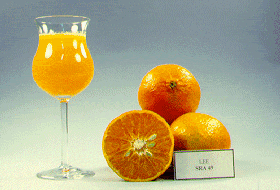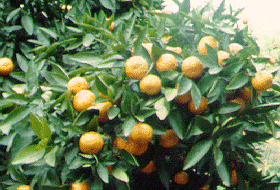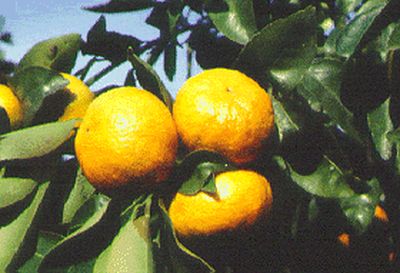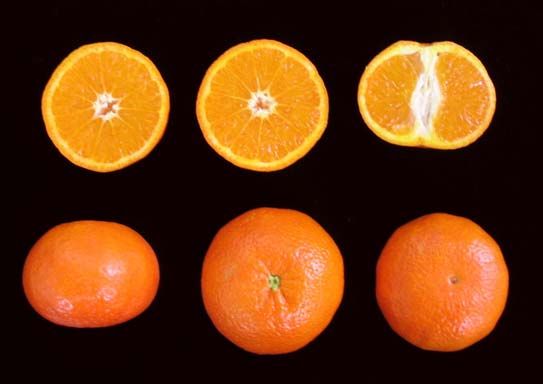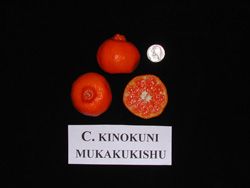|
|||||||||
Select any of 50 available languages! |
|||||||||
Mandarin hybrids
and small-fruited mandarin relatives
For items 1 - 7 and a general introduction to mandarins see the Mandarins page and
Common mandarin, Clementines, Tangerines, Satsumas, Mediterranean (Willowleaf) and King mandarins.
 |
8. Tangors 9. Tangelos 10. Tangelo x Clementine hybrids 11. King and Mediterranean (Willowleaf) hybrids 12. Tangerine, Willowleaf and Tangor hybrids 13. Small-fruited mandarin relatives Sour
mandarin
(Citrus sunki)
Cleopatra (Citrus resni) Shekwasha (Citrus depressa) Nasnaran (Citrus amblycarpa) Kinokuni (Citrus kinokuni) Citrus lycopersicaeformis Citrus oleocarpa |
|
Nasnaran
mandarin Citrus
amblycarpa 'Nasnaran' © C. Jacquemond / INRA |
| Tangors Citrus reticulata × Citrus sinensis |
| LAT | Citrus reticulata Blanco 'Tangor' Swingle |  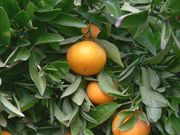  Temple    Ortanique  Ellendale  Murcott   Afourer  Dweet  Ambersweet |
| Syn | Citrus × nobilis Lour. Citrus × tangor Tanaka Citrus reticulata × (Citrus × sinensis) |
|
Citrus reticulata 'Temple' Citrus reticulata 'Ortanique' Citrus reticulata 'Ellendale' Citrus reticulata 'Murcott' Citrus reticulata 'Dweet' Citrus reticulata 'Ambersweet' |
||
Tangor is a hybrid of tangerine (mandarin) and sweet orange. Temple. The origin and history of this variety are somewhat obscure.Temple presumably originated in Jamaica and was introduced to Florida about 1896. As a tree of outstanding quality it came to the attention of W. C. Temple, former manager of the Florida Citrus Exchange. Exclusive propagation rights were obtained in 1916. The variety was named and introduced in 1919. Temple is considered a natural tangor. Rind colour is deep reddish-orange; medium-thick; surface somewhat pebbled or rough, and moderately adherent, but readily peelable. Flesh is orange-coloured, tender, moderately juicy, flavour rich and spicy. Temple tangor is one of the three commercial citrus plants* that produce only monoemryonic zygotic seeds, i.e. the seeds have only one sexually produced embryo, which contains the genes of both parents and therefore the genes of four grand parents. Temple will never grow true-to-type from seed. It can only be propagated by growing cuttings and by grafting buds or cuttings on rootstock. Temple is also known as Magnet and Royal. (* the two others are clementine mandarin and pomelo) Ortanique (Mandora, Or, Orri) Ortanique is reported to have been found on Jamaica around 1920. Because of the presence of wild orange and so-called tangerine trees (local mandarins) in the vicinity of the original tree and the distinctive features of the fruit, it was considered to be a natural tangor, and was given the name Ortanique. The name was a synthesis coined from or(ange), tan(gerine), and (un)ique or jama(ique). Ortanique is an orange × mandarin hybrid that is cultivated in many countries: Spain, Morocco, Cyprus and South Africa among them. Each country has given its own name to the fruit. In Israel it is called Or and Topaz, in Cyprus it is Mandora and in South Africa Tambor and Orri. Other names of this same hybrid are: Artounik, Australique, Mandor, Orantanique, Ormanda, Ortaline, Uruline, Urunique and Villa late. No matter what the name is Ortanique is one of the premium marmalade mandarins. Be sure to include the peel as well. Ellendale This Australian variety is reported to have originated about 1878 as a seedling on the Ellendale property of E. A. Burgess at Burrum, Queensland. It is considered a natural tangor and very similar to Temple. In Queensland Ellendale attains maximum fruit size and excellent quality. It is widely grown in New South Wales, however, and normally commands premium prices because of its large size, attractive colour, and good keeping quality. It is the latest maturing of the varieties currently grown commercially in Australia. Ellendale is also known as: Ellendale Beauty, Ellendale Leng, Grant, Hearne, Leng Ellendale, Savio and Super Malvasio Murcott It is the consensus of Florida horticulturists that this variety is a tangor of unknown origin resulting from the breeding program of the U.S. Department of Agriculture. The oldest known tree is from 1922. Because this fruit has such a thin peel, it is clipped from the tree rather than pulled. The glossy smooth rind clings to the pulp, but is still easily peeled when fresh. The tender flesh has twelve orange-coloured segments with numerous seeds, but there is an abundance of reddish-orange juice with a mango-like sweetness. Murcott is also known as Honey Murcott and Smith and in Florida as Honey. Afourer Afourer (a.k.a. W. Murcott Afourer) is a chance seedling of Murcott (above) from Afourer near Beni Mellal, Morocco, from where it came to California and was released in 1993. Its principal advantages over Murcott are less seeds, better fruit coloration and the fact that it is easily peelable like a clementine. In Morocco it matures in late February. The fruit is low-seeded in the absence of cross-pollination, but seedy when cross-pollinated. The flesh is orange-colored and juicy, with a rich and sweet flavor. In his book Citrus Varieties of the World James Saunt points out that naming new cultivars is seldom straightforward. Afourer is also known in Europe as Nadorcott after Mr. El Bachir Nadori who discovered it in Morocco. In California it is mostly know as W. Murcott but sometimes as W. Murcott Afourer. It is also marketed as Delite. Dweet The Dweet tangor is of Mediterranean Sweet orange and Dancy tangerine parentage. This synthetic tangor resulted from the breeding experiments of H. B. Frost of the University of California Citrus Research Center, Riverside. It was selected in 1930 and introduced in 1950. Fruit medium-large, reddish-orange, globose to oblate-necked, and moderately pebbled. Rind peels poorly and tends to puff. Seedy, very juicy, and of rich flavor. Matures late. Does not hold well on tree, but good for home use. Ambersweet While Ambersweet is classified as an orange both for fresh and processing purposes it is actually a complex citrus hybrid. A mid-season sweet orange was crossed with a clementine × Orlando tangelo hybrid. Since Orlando is a mandarin × grapefruit hybrid Ambersweet, to be precise, is 4/8 orange, 2/8 clementine, 1/8 tangerine and 1/8 grapefruit, it is botanically a tangor. The actual cross was made in 1963 and Ambersweet was released in 1989. Ambersweet is discussed in > Early sweet oranges Other tangor varieties include: Asco, Cinto and Poggio. |
||
| ENG | Temple, Ortanique, Ellendale, Murcott, Dweet and Ambersweet tangors. | |
| FRA | Tangors Temple, Ortanique, Ellendale, Murcott, Dweet et Ambersweet. | |
| Photos | (1-6,11-12) © Gene Lester (7,10) © CCPP (8) © C. Jacquemond / INRA (9) © Joe Real |
|
|
Tangelos Citrus reticulata × Citrus paradisi |
| LAT | Citrus reticulata Blanco 'Tangelo' Swingle |    Minnneola 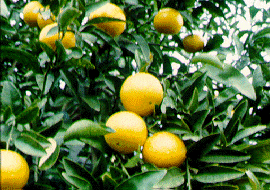 Pearl  Orlando  Sunshine  Allspice  Mandalo   Wekiwa |
| Syn | Citrus × tangelo J.W. Ingram & H.E. Moore Citrus reticulata × (Citrus × paradisi) |
|
| Citrus
reticulata 'Minneola' Citrus reticulata 'Pearl' Citrus reticulata 'Orlando' Citrus reticulata 'Sunshine' Citrus reticulata 'Allspice' Citrus reticulata 'Mandalo' Citrus reticulata 'Wekiwa' |
||
Tangelo is a hybrid of tangerine (mandarin) and grapefruit. Minneola Minneolais a hybrid of Duncan grapefruit and Dancy tangerine produced in Florida by the U.S. Department of Agriculture and named and released in 1931. Its attractive colour, excellent flavour, and low seed content have made it popular. Minneola can readily be recognized by its typical 'neck'. Rind colour is deep reddish-orange; medium-thin, with smooth, finely pitted surface and moderately adherent skin. Flesh orange-coloured, tender, juicy, aromatic; flavour is rich and tart. Medium late in maturity. Minneola is also known as Honeybell. Pearl Pearl is a cross of Imperial grapefruit and Willowleaf mandarin which can be seen in its narrow willow-like leaves. The taste is said to be more grapefruit-like than the taste of other tangelos. The cross was made by Howard. B Frost at the California Citrus Experiment Station in 1929. Orlando Orlando has the same parents as Minneola but opposite characteristics. The fruit is round, tolerates frost better, the taste is sweeter and is early in maturity. Its good shipping quality and pleasant flavour make it a popular tangelo in Florida. Sunshine Sunshine is of the same parentage as Minneola and Orlando.Fruit are large, seedy, grapefruit-like, slightly subglobose to somewhat oblong; colour pale orange. Flesh is orange-coloured and flavour acid. Maturity very late. Tree is vigorous and upright. Allspice Tree and foliage are mandarin-like in appearance. Allspice resulted from a cross of the Imperial grapefruit and Willowleaf mandarin made in 1917 by H. B. Frost of the University of California Citrus Research Center, Riverside. Although the fruit is small, it is attractive because of its rich flavor and spicy fragrance. Fruit medium-small, color orange-yellow, seedy. Rind thin, slightly pebbled, and rather tightly adherent. Flesh tender and juicy; rich, tart, spicy flavor and aroma. Midseason in maturity and loses quality if left on tree much past maturity. Mandalo Mandalo is a cross of Siamese acidless pomelo with a Frua mandarin, which is a cross of King mandarin and Dancy tangerine. To be precise Mandalo is 1/4 King mandarin, 1/4 Dancy tangerine and 2/4 Siamese Sweet pomelo. The fruit can vary from the size of an orange to the size of a grapefruit. This hybrid is discussed on the Grapefruit page as > Cocktail grapefruit. Wekiwa Wekiwa tangelo first came from California in 1930 but was not introduced to the public in Florida until the1980's. Wekiwa is a hybrid of Sampson Tangelo and a grapefruit and therefore should be called a tangelolo. It is delicious, very juicy, of average size for mandarins. The tree is not vigorous but it is very productive and the fruit ripen in January. Wekiwa is unlike any other tangelo because it looks like a mini grapefruit. Under favorable conditions rind pink-blushed and flesh amber-pink. Early in maturity. Wekiwa is also known as Pink tangelo and Lavender Gem. Other tangelo varieties include: Florida, Sunrise, Thornton, Webber and Williams |
||
| ENG | Minneola, Pearl, Orlando, Sunshine, Allspice, Mandalo and Wekiwa tangelos | |
| FRA | Tangelos Minneola, Pearl, Orlando, Sunshine, Allspice, Mandalo et Wekiwa. | |
| Photos | (1,8) © Aggie
Horticulture TAMU (2,4) © C. Jacquemond / INRA (3) © CCPP (5-7) © Gene Lester |
|
| |
||
| LAT | Citrus reticulata 'UGLI ®' |   |
| Syn | Citrus UGLI ® Citrus reticulata x paradisi 'Ugli' |
|
|
The
rather unusual name for this natural tangelo is said to have been given
to this
unattractive but delicious fruit in the Canadian market which first
received
it. It was referred to as the "Ugly" citrus
fruit. Soon
thereafter, the name UGLI® became a copyrighted trademark of Cabel Hall
Citrus
Ltd. Flesh is orange-coloured, tender and very juicy. The flavour rich
and
subacid. Maturity season late. |
||
| ENG | UGLI® Tangelo | |
| FRA | Tangelo UGLI® | |
| Photo | © Trout Hall Ltd. | |
| Link | www.ugli.com | |
|
Tangelo × clementine hybrids Citrus reticulata 'Orlando' × Citrus reticulata 'Clementine' |
|
King × Willowleaf mandarin hybrids Citrus nobilis × Citrus deliciosa |
|
Tangerine x Willowleaf x Tangor hybrids Citrus reticulata x Citrus deliciosa x 'Tangor' |
| Small-fruited
mandarin relatives Of the 36 mandarin species classified by Tanaka 16 cannot readily be classified under the four main species: deliciosa, nobilis, unshiu or reticulata, see Mandarins. Of these sixteen the seven listed below are of commercial importance today. |
| LAT | Citrus sunki Tanaka |   |
| Syn | Citrus reticulata var. austera Swingle | |
|
Sour mandarin is the sunki, suenkat or sunkat of South China. It is the Citrus reticulata var. austera of Swingle's classification that is in the pedigree of both Yuzu (Citrus junos) and Calamondin (Citrus madurensis). It is a medium-small, upright tree with distinctive pale-green leaves. The fruit is medium-small, oblate and markedly depressed at both ends, and with basal furrows. The rind is strong and spicy with a distinctive aroma. The flavour is acid, the fruit never becoming edible. Seeds are medium-large and plump. Citrus sunki is considered to be native to China and is said to be a widely employed rootstock in China and Taiwan.
|
||
| Photo | © Petr Broža | |
| LAT | Citrus reshni Tanaka |   |
|
Cleopatra mandarin is the chota
or billi kichili
of India. The tree is attractive,
round-topped, symmetrical, and thornless, with small, dark-green
leaves. |
||
| Photo |
© UCR CCPP © Aggie Horticulture TAMU |
|
| LAT | Citrus lycopersicaeformis Tanaka | If you would like to share a picture please contact Citrus Pages |
This species is the kokni or kodakithuli of southern India. The fruit is very small, moderately oblate to obconical, deep orange, and has a thin, moderately loose rind. The flesh is somewhat coarse-grained, dry, and acid but becomes edible at full maturity. This species is considered to be native to India and can be found in markets there. Tanaka reports that the heennaran of Ceylon is identical. |
||
| Photo | ||
| LAT | Citrus oleocarpa Tanaka | If you would like to share a picture please contact Citrus Pages |
This species is the timkat of southern China and yuhikitsu of Japan. The fruit is small, yellowish-orange, and somewhat oblate. The base usually has a short radially furrowed neck and the apex is depressed. The rind is medium-thin, relatively tight but readily peelable, and strongly aromatic. Flesh colour is deeper than that of the rind, the texture is crisp, and the flavour is rich but subacid. This species is of Chinese origin and is said to have importance on the Chinese mainland, on Hong Kong Island, and on Taiwan. |
||
| Photo | ||

|
|
Page up-dated 07 December 2009
Back to top of page

